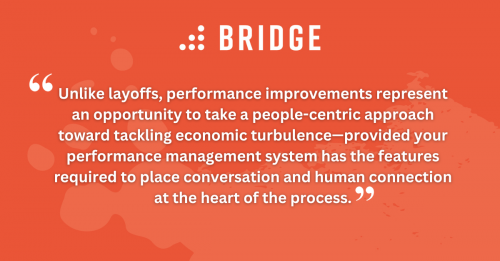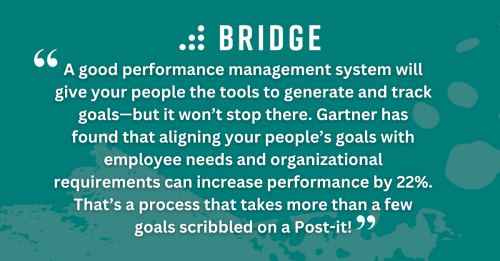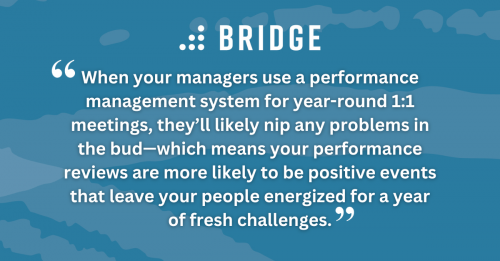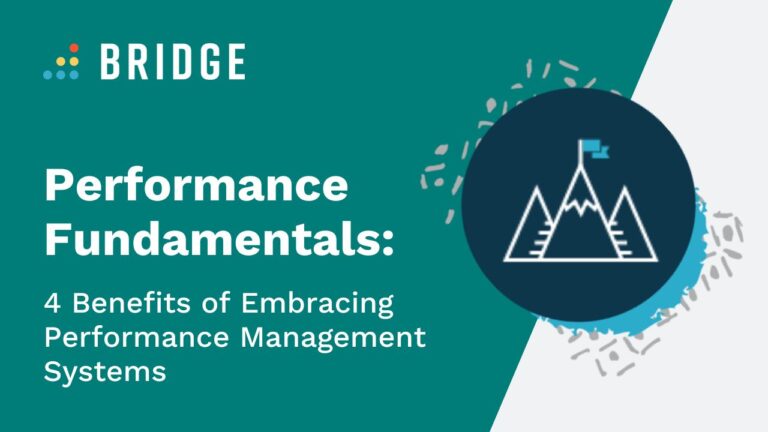The fundamental purpose of performance management is to maximize the value of your employees’ work, thereby improving business outcomes. While this goal has remained unchanged for as long as the concept of performance management has existed, organizations must keep up with current thinking on practices and processes if they’re to get the most out of their people.
Today’s approaches recognize, for example, that strong job performance is tied to support and human connection, as informed by research suggesting that most workers increase the amount of effort they put in wherever workforce wellbeing and equality are championed.
Adhering to today’s vision of good performance management takes more than good intentions, however. It takes a systematized, tech-based approach that draws together personal connections and employee data in order to fully realize the potential of performance management. In other words: it takes a performance management system.
That’s why we’re taking things back to basics with a reminder of the fundamentals that make a good system. Read on to discover what a performance management system is, and how the many and varied features that define the best systems can transform your employee performance.
What Is a Performance Management System?
The nature and function of a performance management system will look different depending on your role.
For employees, a performance management system is a piece of software that gives them the help they need to perform at their best, incentivizes growth and development, and promotes accountability.
Through a manager’s eyes, a good performance platform is a way to measure performance through metrics like goals, keep up to date with employee progress through regular catch-ups, and enhance performance reviews with comprehensive data on their reports’ activities.
Finally, for business leaders, a performance management system is a means of improving business outcomes by maximizing the value of their employees’ work. A business leader might also use this kind of software to perform high-level talent reviews, gaining a bird’s-eye view of their available talent to open up new strategic opportunities for succession planning and similar future-proofing activities.

4 Benefits of a Performance Management Systems
There’s never a bad time to improve employee performance—and, by extension, there’s never a bad time to facilitate those improvements with a good performance management system.
Performance management systems really shine, however, during times of economic uncertainty. Performance management is all about realizing the potential of every employee, improving business outcomes, and maximizing the value your people bring to the table, which makes the practice a great way to boost your business prospects during financial slowdowns.
Unlike layoffs, performance improvements represent an opportunity to take a people-centric approach toward tackling economic turbulence—provided your performance management system has the features required to place conversation and human connection at the heart of the process. Performance management systems are powerful tools with plenty of possibilities, so we’ve narrowed down the feature-based benefits to our top four favorites.
1) Encourage Frequent 1:1 Conversations
Frequent employee-manager 1:1s are a great technique for achieving better performance by way of a people-centric approach to performance management.
A SilverCloud survey has found that 56% of employees experience a loss of productivity when they’re stressed, indicating a clear performance benefit that comes with supporting your people’s emotional needs. At the same time, psychological research shows that social support is a great way to bolster resilience in stressful situations. This, in turn, suggests that forming connections between colleagues through 1:1 conversations is a great way to improve performance even—and especially—in a high-pressure working environment.
Consistent 1:1s aren’t just about improving wellbeing. According to the Chartered Institute of Personnel and Development, regular and high-quality conversations have replaced annual appraisals and numeric rankings as the more worthwhile way to keep your people accountable for their objectives and encourage further development.
A good performance management system can allow you to meet employee expectations for support and connection, and ensure that you’re adhering to today’s performance management best practices. The right platform will, for example, make it easy to create, share, and collaborate on agendas that facilitate communication by making sure both parties have a voice in every check-in. A robust scheduling system, meanwhile, will ensure that your commitment to regular conversations doesn’t fall by the wayside.

2) Create, Remember, and Align Employee Objectives
While some performance management practices, like numeric rankings, have fallen out of favor in recent years, employee goals are still the keystone of any performance management program.
The benefits of goal-setting activities have been recognized for decades, and it’s now firmly established that when employee goals meet the established SMART criteria (which means they’re specific, measurable, attainable, relevant, and timely), you’ll likely see an increase in focus and motivation—which can only improve performance. We advocate for extending the acronym by ensuring goals are SMARTER, meaning they’re also evaluated and revised. This ensures your goals are malleable enough to meet changing individual and organizational priorities.
A good performance management system will give your people the tools to generate and track goals—but it won’t stop there. Gartner has found that aligning your people’s goals with employee needs and organizational requirements can increase performance by 22%. That’s a process that takes more than a few goals scribbled on a Post-it, no matter how SMART they are!
With the right performance platform, however, it’s a simple matter to create team and organizational goals which can then be factored into the individual objectives of each employee, resulting in the ideal combination of personal growth and organization-wide productivity boosts.

3) Enhance Your Performance Reviews
Your platform’s facilitation of frequent 1:1s and comprehensive goal-setting features aren’t just handy in isolation. Together, they allow your managers to provide fair and comprehensive performance reviews.
Historically, performance reviews have gained a reputation for being a difficult experience for both of the parties involved. They require managers to achieve the impossible task of assessing a year’s worth of activity—highs, lows, notable moments, day-to-day performance, and so on—for every one of their reports. This inevitably leads to issues like recency bias, in which managers accentuate the importance of the most recent information about their reports’ work.
Not only is this a stressful and often unproductive experience for managers, but it can leave employees feeling unhappy, as their accomplishments may get overlooked or the value they bring to their organization may not be recognized.
By consistently using a performance management system throughout the year, however, managers will be able to comprehensively review important performance metrics like goal-related progress. Plus, when your managers use a performance management system for year-round 1:1 meetings, they’ll probably nip any problems in the bud—which means your performance reviews are more likely to be positive events that leave your people energized for a year of fresh challenges.
KEEP READING | ‘Performance Review Best Practices for People-First Organizations’
4) Inform Your Talent Reviews With a Bird’s-Eye Perspective
Once your performance management system has provided you with detailed performance data, you can use that information in more expansive ways than localized performance reviews.
By conducting your talent reviews within your performance management system, you’ll gain a great handle on your organization’s talent as a whole, allowing you to locate any skills gaps and add an extra dash of confidence to your succession planning. There’s no better way to evaluate employee potential than by assessing the goldmine of accomplishments, completed objectives, and regular feedback found within your performance management system.
On top of that, a good performance management system will do more than provide performance data—it’ll also allow you to organize that data in a way that works for your talent review process.
Some platforms will, for example, allow you to measure and assess the direction your employees are headed in with custom questions that make sense for your organization. Others will allow you to choose between a traditional nine-box grid or a single-axis view, allowing you to move beyond the subjective or disheartening labels that can sometimes be associated with the nine-box approach and paint a comprehensive picture of your talent and its prospects.
GET THE LATEST TALENT REVIEW INSIGHTS | ‘Rethinking the 9 Box Talent Review’
Take a Holistic Approach to Employee Performance
Clearly, the benefits of a performance management system don’t exist in a vacuum. Linking manager feedback and goals to wider performance and talent reviews ensures that all your performance information is in one handy location, and each advantage informs and supplements the others.
You can take this principle one step further by integrating your performance management system with your learning management system (LMS). This step allows you to link employee goals to relevant training courses (whether eLearning, face-to-face, or blended), to provide you with an extra layer of data while empowering your employees to boost their performance in meaningful ways.
GET MORE PERFORMANCE INSIGHTS | ‘Unlock Your Employees’ Potential With People-First Managers’
Want to Learn How to Select and Implement a Performance Management System?
Bridge Performance Management
Bridge gives organizations the power to engage and develop their people through its performance management platform. In one unified experience, align goals, identify top performers, fill skill gaps, build a culture of continuous feedback, and make informed talent decisions. The platform offers performance reviews, 1on1 agendas, development plans, skills feedback and talent reviews. Bridge has helped organizations build consistency and alignment when it comes to employee development and growth.
Understanding the benefits of a performance management system is just the beginning. Download our ebook, ‘Does My Organization Need a Performance Management System?’, for a comprehensive overview of today’s performance solutions.




